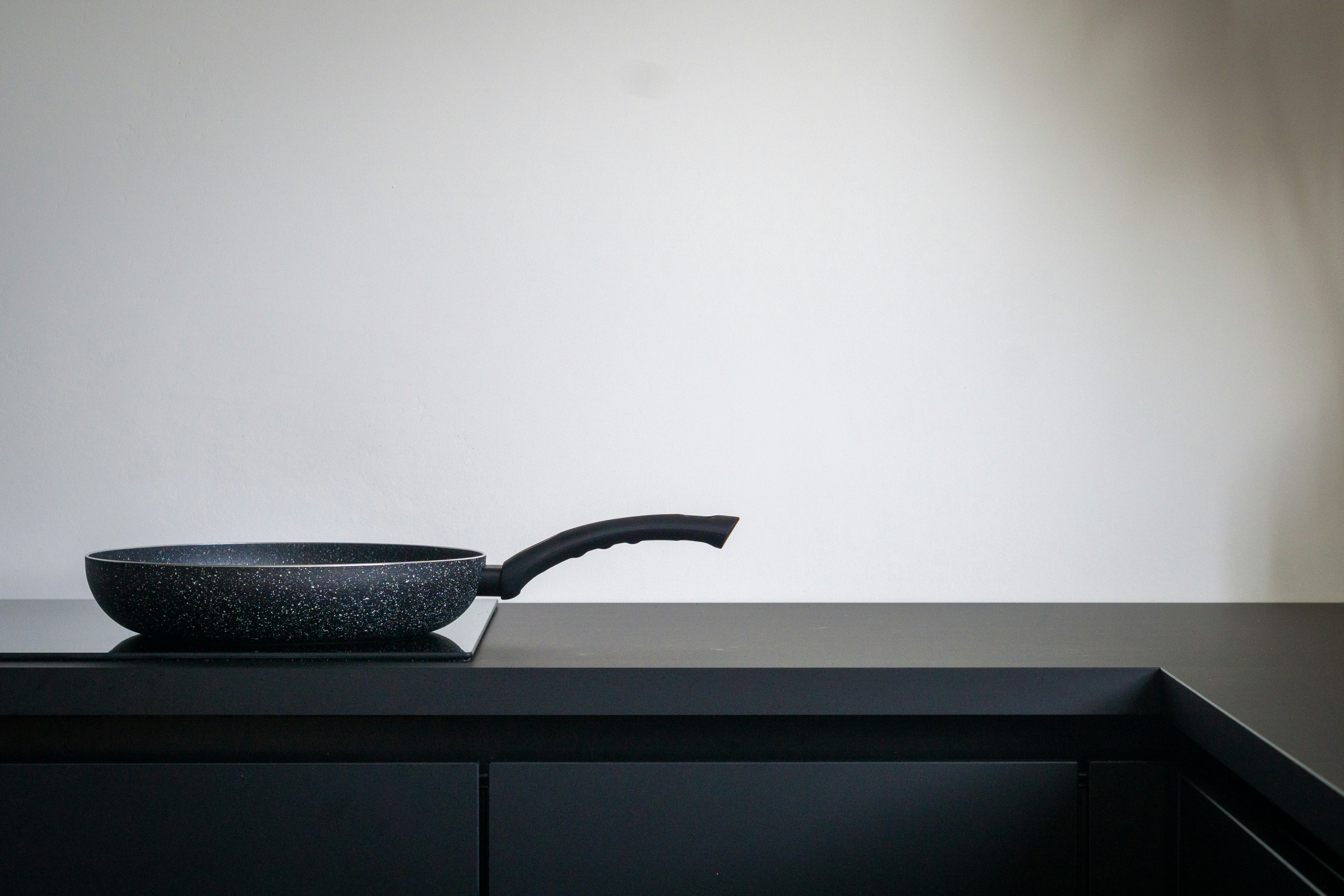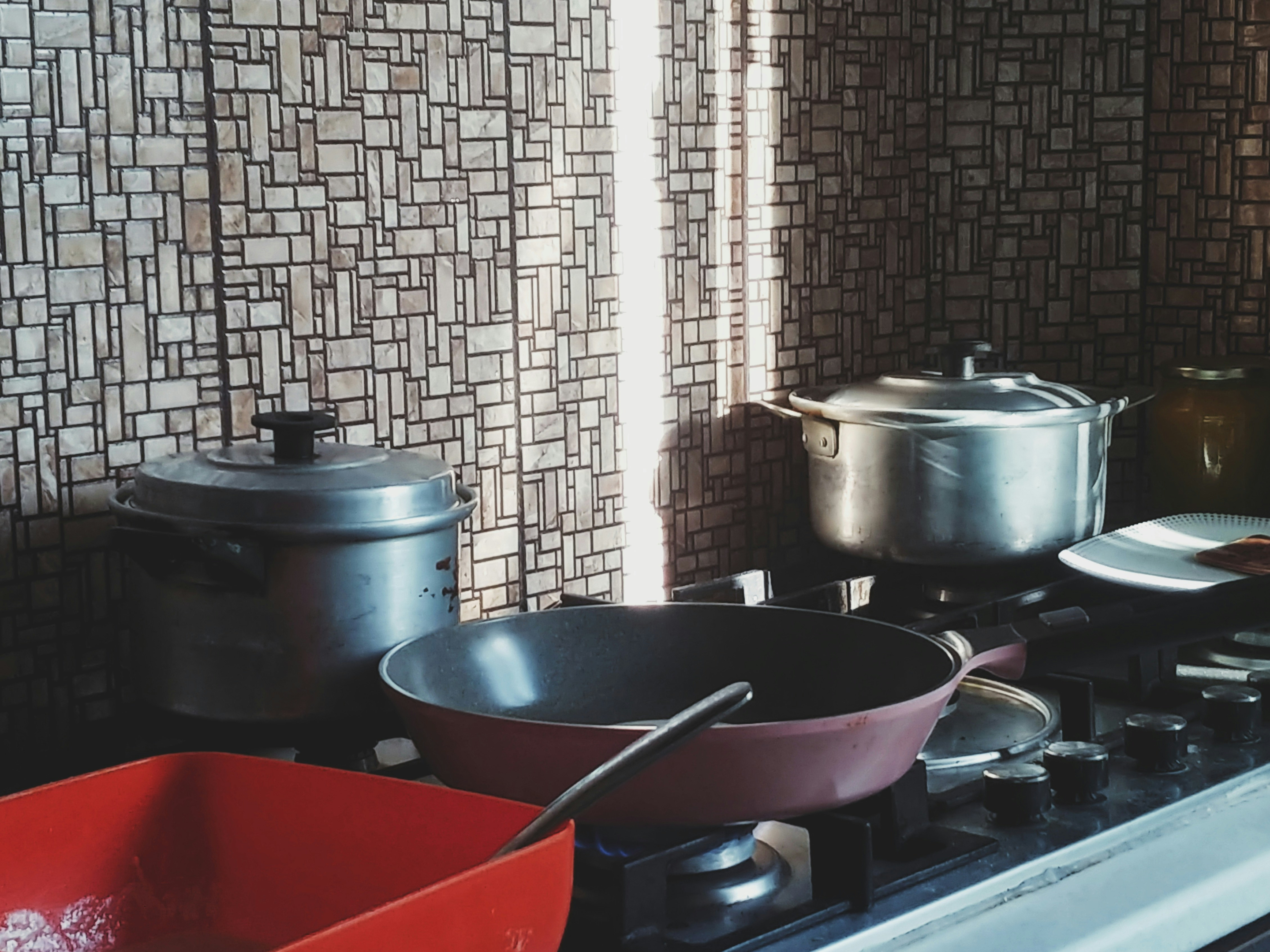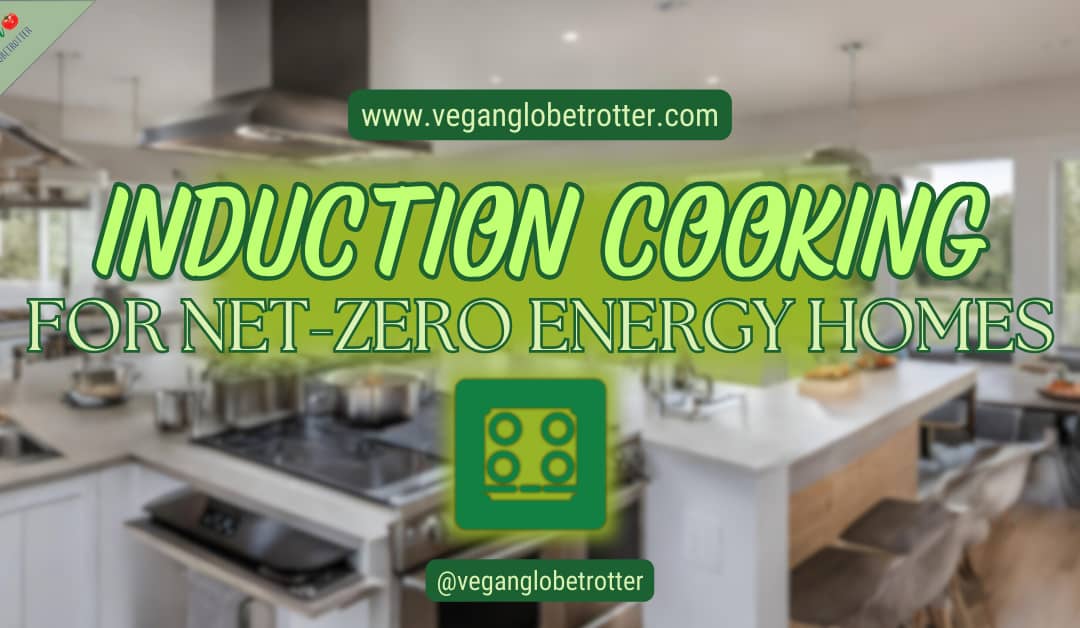Vegan Globetrotter is supported by our audience. When you purchase through one of our links, we may earn a small affiliate commission. As an Amazon Associate I earn from qualifying purchases. Your cost is not affected.
==================
Induction cooking stands at the forefront of eco-friendly home technology. It presents a viable solution for those aiming to build or transition to net-zero energy homes. As someone who personally uses an induction cooker, I cannot stress enough how amazing it is.
Unlike traditional electric or gas stoves, induction cooking uses magnetic fields that directly heat pots and pans. This results in a highly efficient cooking process. This method significantly cuts down on wasted energy, as heat is generated almost instantaneously and is confined to the cookware, minimizing ambient heat loss commonly associated with induction ranges and with other cooking methods. If you are eager to learn more about induction cooking, then this article is the right one for you.
Induction Cooking for Net-Zero Energy Homes: Culinary Innovation’s Role in Sustainability
As homeowners become more environmentally conscious, the allure of induction technology in kitchens grows. The seamless integration of induction cooktops into net-zero energy homes illustrates a commitment to reducing carbon footprints while embracing modern aesthetics and culinary performance.

Sleek in design and user-friendly, these cooktops offer a clean, efficient way to prepare meals while aligning with the electrical frameworks of solar-powered, energy-efficient homes. Moreover, the dropping prices and growing market adoption suggest a positive trend toward a sustainable, decarbonized lifestyle.
Key Takeaways
- Induction cooking enhances energy efficiency in the kitchen.
- Modern cooktop designs complement net-zero energy home goals.
- Market trends show increasing accessibility and adoption of induction technology.

Fundamentals of Induction Cooking

Photo by Sven Brandsma on Unsplash
Induction cooking is a game-changer for culinary efficiency and energy conservation. It’s a method that harnesses electromagnetic energy to heat cookware and produce heat directly.
Electromagnetic Principles
Induction cooktops utilize a coil of copper wire located beneath the cooktop surface. When you turn on the power, an alternating electric current flows through the coil, creating a dynamic magnetic field on a smooth surface. This field induces an electric current in your magnetic cookware, producing heat.
Contrary to conventional cooking methods, the heat is generated directly in the pot or pan rather than by a heating element, improving energy and heat transfer efficiency.
Key Points
- Copper Coil: Generates a magnetic field when powered by electricity.
- Magnetic Field: Induces an electric current in magnetic cookware.
- Heat Generation: Occurs directly in the cookware, not the cooktop.

Photo by Mazda Mehrad on Unsplash
Advantages Over Traditional Cooking Methods
Induction cooking presents several advantages over both gas cooking and traditional electric cooking. It boasts speed; your cookware heats up faster since the energy is directly transferred. It contributes to safety; the cooktop stays relatively cool as heat is produced in the cookware, reducing burn risks. Moreover, it enhances precision cooking; you get immediate power adjustment and it allows for consistent, controlled temperatures.
Energy Efficiency: With magnetic induction cooking, less energy is wasted as almost all of it goes directly into heating the cookware.
Cleaner and Greener: Induction cooking is recognized for its potential to help homes move towards net-zero energy goals by reducing reliance on fossil fuels and improving kitchen air quality.
Potential Cost Savings: While induction cooktops might have a higher initial cost, they can lead to savings in the long term through higher energy efficiency and shorter cooking times.
Induction Cooktop Design and Features
When selecting an induction cooktop, you’ll find that designs and features can significantly influence your cooking experience, energy consumption, and safety.
Cooktop Types and Sizes
Induction cooktops are available in various types and sizes to fit diverse kitchen needs. The typical sizes range from compact 24-inch widths to spacious 36-inch models. Some cooktops offer flexibility with modular designs, allowing you to customize your cooking surface with different modules.
Control and User Interface Options
The controls on induction cooktops vary by model, offering either traditional knob controls or modern digital touch interfaces. Many cooktops feature precise temperature control, providing you with the ability to make quick adjustments as needed.
For even more precision, some options include 15 power settings, which are essential for cooking delicate dishes or searing meats.
Safety Features and Functions
Your safety is paramount when it comes to induction cooktops. A common feature is the pan detection system, which ensures that heat is generated only when a pan is present, significantly reducing the risk of burns.
Moreover, many models include a safety lock to prevent accidental changes to the settings, making them safer around children.

Energy Efficiency of Induction Cooking
Induction cooking stands out as a highly efficient technology for your net-zero energy home. Unlike traditional electric or gas cooktops, induction cooktops work by generating a magnetic field that directly heats your pots and pans, rather than heating the cooktop surface itself.
This direct transfer of heat energy means that you can achieve up to a remarkable 90% energy efficiency with induction cooking, a significant increase over electric coils, which average around 60%, and gas, which comes in at about 50%.
Moreover, studies have shown that the time-of-use value of energy in relation to induction cookware can contribute to cost savings, which is crucial in creating a sustainable, more energy-efficient home.

Photo by George Evans on Unsplash
Reducing Carbon Footprint with Induction Cookware
By choosing induction cookware, you’re not only enhancing efficiency but also contributing to a lower carbon footprint for your household.
Induction cooking utilizes electricity, which can be sourced from renewable energy systems such as solar PV panels integrated into your net-zero energy building design. As emphasized in the provided research, this shift from fossil fuels to renewable sources is vital in the transition to net-zero energy housing.
The increased efficiency and potential for green energy sourcing can drastically reduce the overall energy consumption of your kitchen, aligning your culinary practices with the environmental goals of net-zero living.
Installation and Electrical Requirements
When you’re installing an induction cooktop, understanding the power supply and wiring requirements is crucial for safety and compatibility with your home’s electrical system.
Power Supply and Wiring Needs
Your induction cooktop requires a dedicated electrical circuit to ensure it has enough power and to prevent overloading your home’s electrical system.
Specifically, for a 15″ induction or electric cooktop, you will need a 20 amp dedicated circuit, while a 24″ induction cooktop or range will require a 30 amp dedicated circuit.
The electrical supply for electric stove should be a 3-wire, 240/208 VAC, 60 Hz, and a flexible conduit of at least 4 feet is recommended to connect your cooktop.
- Electrical Requirements for Induction Cooktops:
Cooktop SizeCircuit RequirementVoltageFrequency15″20 amp dedicated240/208 VAC60 Hz24″30 amp dedicated240 VAC60 Hz
Compatibility with Home Electrical Systems
To ascertain compatibility with your home electrical system, you must have a clear understanding of your current system’s capabilities.
Most modern homes are equipped to handle the required electrical load, but older homes may need an assessment and potential upgrade.
You must verify that your home can handle the additional amperage before installation to prevent any safety hazards.
Key Compatibility Considerations:
- Verify existing electrical panel capacity for the added circuit.
- Ensure proper gauge wiring is used for the specified amperage.
- Consult a licensed electrician to confirm home compatibility.
Economic Considerations
Making the switch to induction cooking in your journey to net-zero energy homes involves a careful evaluation of costs and savings. Your decisions will have financial impacts both short-term and long-term.

Cost-Benefit Analysis
When considering induction cooktops, you’re looking at a higher upfront cost compared to traditional gas or electric cooktops. However, induction cooktops offer greater energy efficiency.
Recent studies suggest that you can expect energy savings of 5% to 20% over traditional electric cooktops and more than 65% over gas cooktops. This means long-term savings on your energy bills that could offset the initial investment.
Here’s a simple breakdown:
- Initial Cost: Induction cooktops = Higher upfront cost
- Operational Efficiency: Induction = Lower energy consumption
- Long-term Savings: Induction = Potential for reduced utility bills
Keep in mind, the exact figures depend on your local energy prices and usage patterns.
Incentives for Energy-Efficient Appliances
To promote energy efficiency, governments and utilities often offer incentives that can lower your costs. For induction cooktops, you may find rebates or tax credits that can significantly reduce the purchase price.
Checking with local energy programs can guide you towards available incentives.
Your investment in induction technology not only moves you closer to a net-zero energy home but also contributes to broader environmental benefits, often recognized and encouraged through these financial incentives.
Consumer Behaviors and Market Trends
In this section, you’ll discover how adoption rates reflect changing consumer behaviors and why environmental awareness is shaping the induction cooking market.

Adoption Rates and Barriers
Induction cooking is gaining popularity due to its energy efficiency and cooking speed.
For instance, induction cooktops have been reported to boil water 20-40% faster than gas or traditional electric ranges.
Yet, barriers to adoption exist, such as the initial cost of purchasing induction-ready cookware and the need for compatible 240-volt outlets, much like those required for radiant electric stoves.
- Initial Costs: The need for new cookware and potential kitchen wiring upgrades.
- Knowledge Gaps: Consumers may not understand the benefits of induction cooking.
Influence of Environmental Awareness
Your environmental concerns are driving changes within the induction cooking market.
You may find it encouraging that induction technology is known for its ability to reduce energy consumption and, consequently, your carbon footprint.
As a homeowner, your shift towards sustainable cooking methods is part of a larger trend towards net-zero energy homes.
- Efficiency: Induction cooking offers precise and even heating.
- Market Growth: Environmental awareness contributes to a market expected to grow substantially through 2025.
Technological Advances and Future Developments
The transition to net-zero energy homes is increasingly reliant on advancements in kitchen technology, particularly through the integration of smart features and continuous innovations in induction cooking appliances.

Smart Home Integration
Your modern kitchen can seamlessly integrate with smart home systems, allowing for increased convenience and energy efficiency.
Induction stoves now can connect to your Wi-Fi network, enabling you to control them via voice commands or through smartphone apps.
Features such as remote temperature monitoring, scheduled cooking times, and energy consumption tracking ensure that your cooking experience is both sophisticated and sustainable.
Innovations in Induction Technology
The future of induction technology speaks to greater energy efficiency and a reduced carbon footprint.
Recent innovations focus on more responsive cooking surfaces and the use of multi-phase wiring to deliver precise temperature and heat control.
For example, newer models are being developed to function efficiently without the need for costly electrical upgrades, as seen with the Induction Stove Challenge in New York.
These stoves are not only designed to fit into existing infrastructure but also to meet stringent energy efficiency criteria.
Induction Cooking: Embracing Sustainable Culinary Innovation
As we end, we can say induction cooking emerged as a game-changer in eco-friendly home technology. Its utilization of magnetic fields for heating cookware revolutionized culinary efficiency, boasting speed, safety, and precision.

Throughout the article, we explored how induction cooking aligned with the goals of net-zero energy homes, offering energy efficiency and sustainability. From its design features to installation requirements, induction cooktops seamlessly integrated into modern kitchens while reducing carbon footprints.
As a homeowner embracing sustainability, the journey towards net-zero energy living felt both personal and relatable. Induction cooking not only offered tangible benefits but also symbolized a broader movement towards a greener future.
In essence, induction technology represents our collective pursuit of a more sustainable lifestyle, guiding us towards a harmonious coexistence with our environment.
Frequently Asked Questions
When you’re evaluating induction cooking as part of your net-zero energy home design, you may have several questions about its contributions, costs, and impacts. Below are specific answers to some of the most common questions.
How Does Induction Cooking Contribute to the Goal of Net-Zero Energy Homes?
Induction cooking can be highly efficient, utilizing less energy than conventional electric or gas cooktops.
By directly heating cookware via an electromagnetic field, it reduces the amount of lost heat, improving the overall energy efficiency of your home.
What Are the Cost Considerations When Incorporating Induction Cooking Into a Net-Zero Energy Home Design?
While induction cooktops may have higher upfront costs compared to traditional ranges, they can offer savings over time through reduced energy bills and less wasted heat.
It’s important to evaluate long-term savings when considering the overall investment in a net-zero home.
Are There Any Noise Concerns With Induction Cooktops in a Residential Setting?
Induction cooktops can produce a low humming sound when at high power, typically due to the cooling fan or the vibrations from the electromagnetic fields interacting with the glass surface of the cookware.
This sound is generally minimal and should not pose significant noise concerns in a home setting.
What Are the Potential Environmental Benefits of Using Induction Cooking Technology?
Induction cooking offers environmental benefits such as reduced energy consumption and decreased reliance on fossil fuels.
Because of the efficient transfer of energy directly from the induction burner to the cookware, there is less ambient heat and energy wasted, contributing to lower greenhouse gas emissions.
What Specific Electrical Requirements Are Necessary for Installing an Induction Stove in a Home?
To install an induction stove, your home will need a dedicated electrical circuit that typically requires 240 volts, similar to other large appliances.
It’s important to consult a professional electrician to ensure that your electrical system can support the specific model of the first induction range or cooktop you choose.
How Does the Energy Efficiency of Induction Cooking Compare to Traditional Electric Cooking Methods?
Induction cooking is significantly more efficient than traditional electric cooking methods. It boasts an efficiency of approximately 85% compared to electric resistance cooking which hovers around 74%. This efficiency helps the cook to reduce overall energy use in the pursuit of a net-zero energy home.
Related Articles
I hope that you enjoyed reading this article, and if you want to know more about induction cooking, then here are several articles that I think you might enjoy.







Don't miss out
when new recipes and information are added!
Join our newsletter for free recipes,
healthy living inspiration, and special offers
You have Successfully Subscribed!